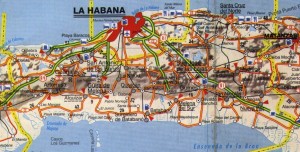Cities, Provinces, & Villages
 These are the largest cities in Cuba.
These are the largest cities in Cuba.
All figures are accurate as of 2003.
Havana is the capital city, major port, and leading commercial centre of Cuba. The city is one of the 14 Cuban provinces. The city/province has 2.4 million inhabitants, and the urban area over 3.7 million, making Havana the largest city in both Cuba and the Caribbean region The city extends mostly westward and southward from the bay, which is entered through a narrow inlet and which divides into three main harbors: Marimelena, Guanabacoa, and Atarés. The sluggish Almendares River traverses the city from south to north, entering the Straits of Florida a few miles west of the bay. In 1959 the city halted its growth, and since then has suffered a net loss of living units, despite its population increase.
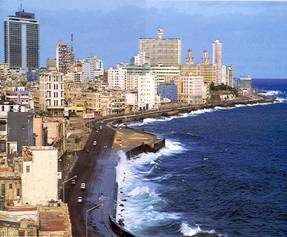 •Havana, 2
•Havana, 2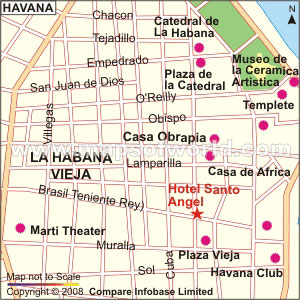 ,201,610
,201,610- •Santiago de Cuba, 423,392
- •Camagüey, 301,574
- •Holguín, 269,618
- •Santa Clara, 210,220
- •Guantánamo, 208,145
- •Bayamo, 144,664
- •Victoria de Las Tunas, 143,582
- •Cienfuegos, 140,734
- •Manzanillo, 132,789
- •Pinar del Río,139,336
- •Matanzas, 127,287
- •Ciego de Avila, 106,225
- •Sancti Spiritus, 98,283
- •Cardenas, 80,832
- •Palma Soriano, 76,179
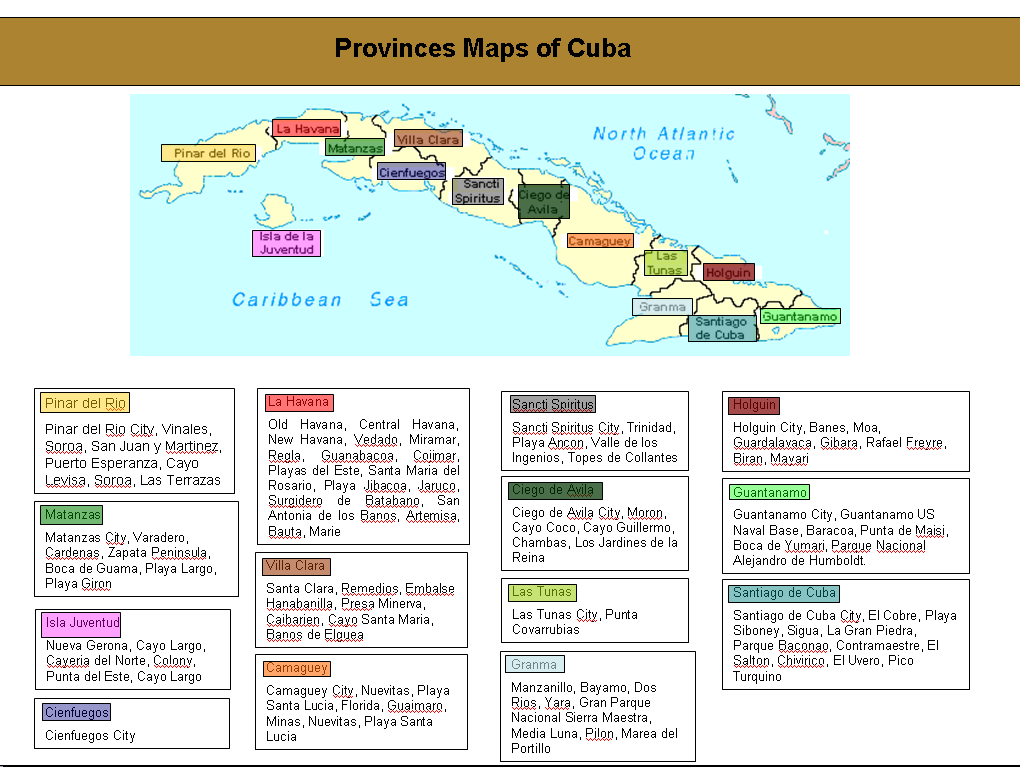
|
|
Pinar del Rio
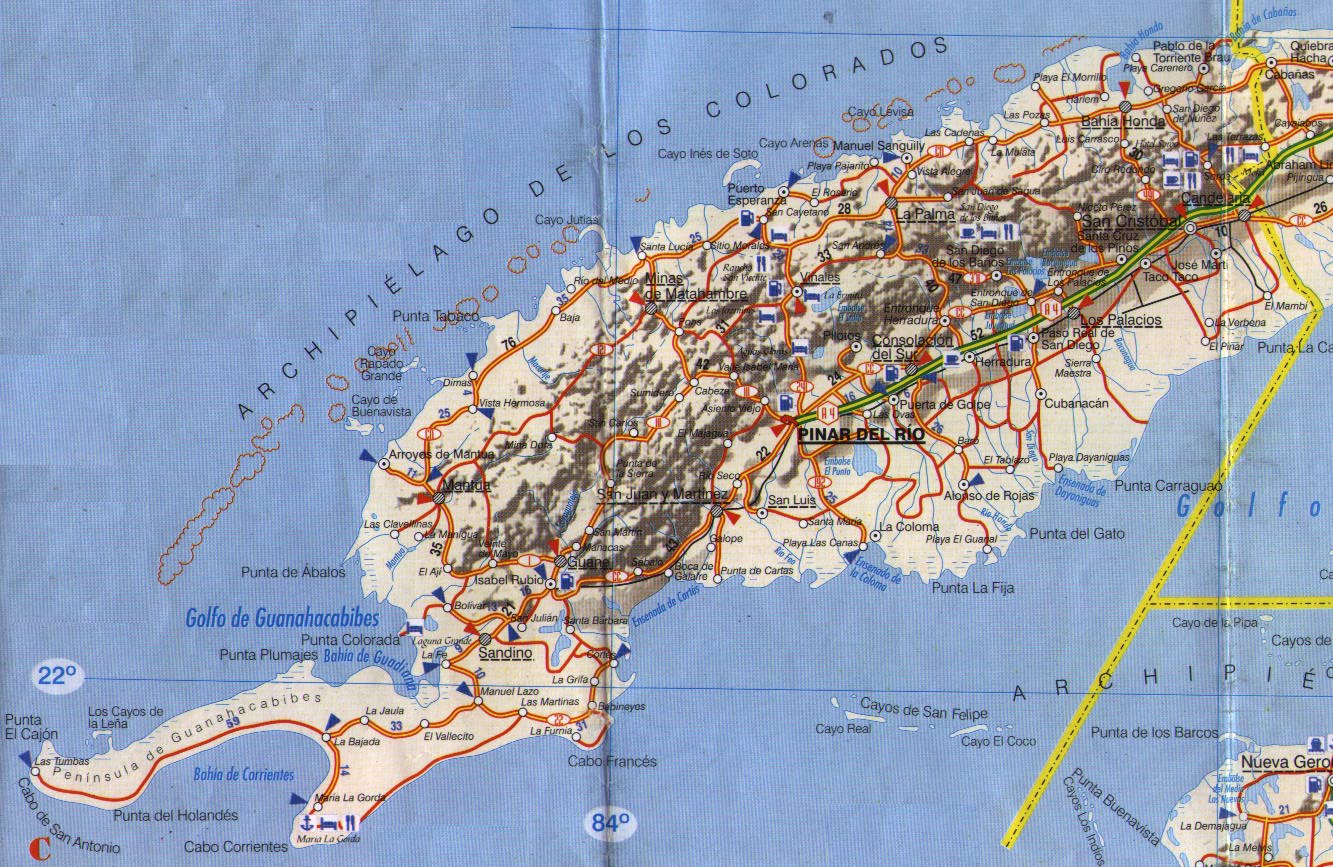
Cuba’s westernmost province of Pinar del Rio boasts two of the six UNESCO Biosphere Natural Reserves on the Cuban archipelago and contains the Valle de Viñales or Viñales Valley, also declared a World Landscape Heritage Site by UNESCO for its strange and stunning mogotes, round-topped, cliff-like hills covered with lush vegetation. Pinar del Rio is also the region where the country’s, and arguably the world’s, finest tobacco is grown.
The Pinar del Río province contains one of Cuba’s three main mountain ranges, the Cordillera de Guaniguanico, divided into the easterly Sierra del Rosario and the westerly Sierra de los Organos. These provide for a preponderance of fertile valleys, called hoyos, and the mogotes which much are essentially flat-topped buttes made of limestone and peppered by caverns and subterranean rivers.Along the coast there are excellent yacht anchorages, clear waters, spectacular corals and great expanses of empty white-sand beaches.
Also scenes of oxen tilling red-earth fields and cowboy peasants, called guajiros, on horseback, are commonplace.
Cayo Levisa
About 20 kilometers from the Vinales Valley, off the northwest coast of Cuba, lies a cluster of tiny islands enveloped by thick jungles of tropical mangrove and bordered by fabulous white beaches. The most idyllic amongst these is Cayo Levisa.
This small coral key off the north side of Pinar del Rio is part of the Archipelago de los Colorados, which sits in the Gulf of Mexico. It’s known for its white coral beaches, thick mangroves, abundant seabirds, and seas rich in red snapper, sea bass, lobster, marlin, and other species.
From the early 1940s, American author Ernest Hemingway had a fishing camp on Cayo Paraiso, a smaller coral island 10km east. Recently an exclusive tourist resort has been built on Cayo Levisa.
There are 23 diving points on the island shelf, which has numerous coral formations, an ideal location for snorkeling.
Guanahacabibes Peninsula
At the westernmost tip of Cuba, in the Pinar del Rio province, you can find one of the most virgin natural zones in the Cuban archipelago. The Guanahacabibes Peninsula region, due to its treasures of flora, fauna, and for its sea and terrestrial landscapes, has been a Biosphere Reserve as declared by UNESCO since 1987.
On the coast of the “Reserva de la Biosfera Península de Guanahacabibes” are many beautiful white sandy beaches. And off the coast are extensive coral reefs. All of which are some of the most pristine in the world. Visitors are able to experience dozens of dive sites off the southern shores, from Maria La Gorda International Diving Centre, and now dozens more off the northern shores, from the new Cabo San Antonio International Diving Centre.
Birds like Cartacuba, Tocororo, Sijú platanero, Zunzuncito, among many others, are to be found in a migration corridor of more than 50 species flying from north to south and vice versa, and stopping in the coastal lagoons and wetlands.
Guanahacabibes also supports 35 species of reptiles, and is an important habitat for iguanas, majaes and other reptiles.
N.B. Biosphere reserves are sites recognized under UNESCO’s Man and the Biosphere Program which innovate and demonstrate approaches to conservation and sustainable human development. The 121,572 hectare “Reserva de la Biosfera Península de Guanahacabibes” has within it the 39,901 hectare national park since 2001 “Parque Nacional Península de Guanahacabibes” and the two strictly protected nature reserves since 1963 “Cabo Corrientes” and “El Veral”.
Pinar del Rio City
The area has a good reputation for the production of high-quality ceramics and woven work and it is famous his Neoclassical buildings. Although there is a fair amount of traffic and activity on the streets, the city gives the impression of being geographically isolated as well as a little behind the times.
Among the main places to visit are the Provincial Museum of the History of Pinar del Rio, Museum of Natural Sciences, Tobacco Museum and Calle Jose Marti.
Puerto Esperanza
Puerto Esperanza, 6km north of San Cayetano and 18km north of Rancho San Vicente de Vinales, is a sleepy little port often visited by yachts sailing around the country. The locals swim from a long pier pointing out into the bay.
San Diego de los Baños & La Güira National Park
Just west of the Sierra de los Rosario, in the foothills of the Sierra de los Organos, you’ll find La Güira National Park and San Diego de los Baños. La Güira is a small park that is a favorite stop for bird-watching tours and general sightseers. San Diego de los Baños is a tiny town built on the edge of a lovely river.
The well-gained fame of San Diego de los Baños dates back some centuries ago, exactly to 1632, when a fortuitous event involving a slave brought to light the almost miraculous properties of its springs.
The anecdote – almost a legend – about Taita Domingo, a slave whose masters had granted him his freedom because he was seriously ill with skin lesions, and who wandered around the farm, has survived the passing of time.
During one of his walks, Taita Domingo discovered a spring later called La Gallina, which waters relieved and even cured his ailment, thus marking the beginning of a new era for that eastern Cuban region.
San Juan y Martinez
Amid fields of big green leaves ripening in the sun and plantations covered in canvas sheets for the all-important cigar-wrapper leaves stand gorgeous wooden barns called casas del tabaco. Here leaves are hung on poles with a needle and thread to turn from green to brown.
Sandino
Fishing is the main economic resource, and is the gateway to the Guanahacabibes peninsula, a UNESCO Biosphere Reserve.
The municipality of Sandino has 40184 inhabitants and a population density of 23.5 inhabitants per km2.
Soroa & Las Terrazas
Soroa, also known as Cuba’s Rainbow, is 70 kilometers west of the Cuban capital. It is a site of breathtaking natural beauty, with a 22-meter waterfall that invites visitors to take a refreshing swim any time of the year.
The region’s unspoiled lush environment is perfect cycling and mountain climbing, with excursions on the banks of the Manatiales River and unique baths at the so-called “Poza del Amor” (Pond of Love).
One big attraction of Soroa is the nearby botanical gardens which contain an excellent orchidarium, home to more than 700 different types of orchid. The surrounding countryside is lush, hilly and very pleasant to wander around.
For those into bird watching, there are several viewing stations dotted around, for photographers; the area can affords a good opportunity for fauna and flora shots.
Las Terrazas is situated in Sierra del Rosario, one of Cuba’s natural strongholds, which was designated a Biosphere Reserve by the United Nations Educational, Scientific and Cultural Organization (UNESCO) in 1985.
The history of coffee cultivation, which started in the region in the 19th century, is one of the major attractions for customers at the Buenavista Restaurant, which was built on the ruins of the coffee farm of same name, founded by French immigrants.
Las Terrazas Community, with its beautiful white houses with colorful roofs, surrounded by ponds and gardens, adds a peculiar touch to Cuba’s rural landscape.
Vinales
It is famed for its mogotes, large limestone formations which date back to the Jurassic period, is one of the most beautiful spots in Cuba.
This village town is surprisingly spruce, with a fetching arcaded main street and lovely rustic scenes down the back lanes, the tranquility of the place and the friendliness of the local people are as seductive as the scenery, there are walks to do, horses to hire and tobacco farms and caves to visit.
Matanzas
This province is one of the most popular areas for visiting tourists, largely because of its varied topography and natural beauty.
The north of the province is marked by rolling hills and the beach resort of Varadero; the south is home to a large area of swamp land and the beach of Giron, better known as the Bay of Pigs.
Central Matanzas is a long stretch of rolling plains whose red and fertile soils produce the highest yield of sugar crop in the country. Other crops such a tobacco, citrus fruits and vegetables are also produced in abundance. 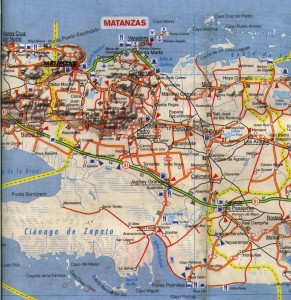
Cardenas
The city is laid out in a typical grid pattern with the most important street, Avenida Cespedes, intersecting Parque Colon, the focal point for city life,
Other places to visit are Oscar Maria de Rojas Museum, Catedral de la Immaculada Concepcion, Plaza Molokoff, Casa Natal de Jose Antonio Echevarria…
Jaguey Grande
Jaguey Grande is at the gateway to the Zapata Peninsula, Guama, Playa Larga, Bay of Pigs and Playa Giron. 2007 was Jagüey Grande’s 150th anniversary of it’s foundation.
Jagüey Grande is surrounded by 40,000 hectares of citrus trees. The mostly oranges and grapefruits are processed at the modern “Heroes of Giron” plant and accounts for 60 percent of national production. The citrus fruit are used to produce concentrate, juices, mash, beverages and essences which are exported, or bottled at the next door factory Rio Zaza and distributed under the Tropical Island brand.
In the neighborhood of Jaguey Grande is a big sugar mill. From here Fidel Castro took control of the counterattack against the invasion in the Bay of Pigs (Bahia de Cochinos). The airstrip at Jagüey Grande was seized, but when the first invaders B-26 came in to land, it hit ridges of sand that had drifted across the runway, and crashed. Paratroopers that dropped inland were wiped out, and the invaders from the beach never reached Jagüey Grande. There is a little museum of Fidel Castro’s office in the sugar mill, and in Havana in front of the Museo de la Revolucion is the Sau-100 tank used by Fidel Castro during the invasion.
Matanzas City
Matanzas often calle “the Athens of Cuba” and famous for its many bridges, interesting architecture and music is on the way to famous Varadero Beach. Birthplace of the Danzón, Matanzas is also a good place in which to hear a danzonete or rumba. A city on the sea, it has drawn on the rhythm of the waves, the vigor of its morning breeze and the stately calm of its rivers in creating its culture.
Matanzas, behind a deep bay, it came into its own during the 19th century when it served as the country’s sugar capital. On the classic, leafy main square, Parque Libertad, the Pharmaceutical Museum is a wonderfully preserved chemist’s shop; also there are plenty of interesting buildings, monuments and museums to keep you occupied like Museo Historico Provincial, Teatro Sauto, Cathedral of San Carlos, Bellamar Caverns…

Playa Giron
Playa Giron, on the eastern side of the famous Bay of Pigs (Bahia de Cochinos), 48km south of Boca de Guama, is named for a French pirate who frequented the area centuries ago. The CIA-sponsored landing here on April 17, 1961, was defeated within 72 hours, as a museum and many monuments proclaim. In all, 200 invaders were killed, 1197 captured, and 11 hostile planes shot down. You really get the feel of reliving history by coming here, and the clear Caribbean waters washing these shores make Playa Giron a favorite destination for scuba divers and snorkelers. A lasting legacy of 1961 is that the entire Bay of Pigs area is strictly out of bounds to cruising yachts.
Playa Giron’s main resort is rather pleasant, and a huge seawall provides a protected swimming area. Long, white Playa Los Cocos, where the snorkeling is good, is just a five-minute walk south along the shore. The rocky soils of this region are of little use for agriculture and the population is sparse. Distances are long and public transportation is poor, so unless you’ve rented a car, you’d better be prepared to rough it.
Varadero
Varadero, in the western Cuban province of Matanzas, is the beach par excellence in the archipelago, despite strong competition from islets in the Jardines Del Rey tourist region.
Over 24 kilometers of excellent beaches, closely linked to other natural attractions such as caves, virgin keys and transparent waters, are complemented by a strong infrastructure that can satisfy the needs of the most demanding vacationers.
Marinas such as Chapelin, Puertosol, Darsena de Varadero and Gaviota guarantee excellent conditions and means to go diving, including appropriate boats, trained personnel, diving centers, hyperbaric chambers and means of transport in case of an emergency.
Thousands of rooms for international tourism, run by major international hotel companies linked to the leisure industry, are complemented by a broad network of extra-hotel facilities that have expanded along with the increase in the number of vacationers who bet on that tourist destination.
Varadero also holds the International Parachuting Center and the Varadero Golf Club, the first 18-hole-par-72 professional golf course in Cuba.
The Plaza America Convention Center, with its 600-seat plenary hall and seven additional halls, hosts major international events and meetings, becoming an excellent choice in programs that combine leisure with work in a pleasant and calm atmosphere.
Yumuri Valley
Located in the vicinity of the city of Matanzas, Yumuri is one of the most picturesque landscapes in Cuba. A river of the same name, which banks were once home to native Indian populations, runs at the bottom of this 8km wide Yumuri valley.
The Yumuri Valley is fringed by a 150 m-high mountain ridge, broken only to the west. The top of those elevations are excellent natural lookout points to admire the view across the Valley, including as a significant site, the Monserrat Hermitage built by Catalonian immigrants.
Since colonial times, sugarcane and vegetable plantations alternate with magnificent royal palm (Roystonea regia) trees-the Cuban national tree- in the Yumuri Valley.
This singularly attractive rural landscape is the backdrop to the Horizontes Casa Del Valle Hotel, located just 3 km away from Matanzas and a one-hour-drive away from Varadero. It offers an ideal setting for the practice of outdoor activities, including trekking and hiking, horseback riding and cycling. Several paths and trails are available for ecotourism: La Tierra de los Caracoles trail leads to an ancient aboriginal site and a flower farm; El Abra trail on the Bacunayagua River takes visitors through areas rich in vegetation and ends up at the river mouth for seabathing. Both adults and children can go along these trails as they are not difficult to climb.
The facility also offers programs against stress, obesity, hypertension and asthma, which feature ozone therapy, dieting, massage, acupuncture, Thai chi and other therapies.
Zapata National Park & Playa Larga
Parque Nacional Ciénaga de Zapata covers 628,171 hectares. Is the main wetland in Cuba, as well as the largest (and well-preserved) of the Caribbean Islands. The Zapata Peninsula biosphere is a huge natural reserve for all manner of wildlife including local and migratory birds, lizards, crocodiles and rock crabs.
Zapata Biosphere Reserve shows a great diversity of ecosystems such as grasslands; mangrove, Ciénaga, semi-deciduous, evergreen coastal and sub-coastal forests; coastal and sub-coastal shrubbery and coral reefs with principal coral species and coastal lagoons. The area also supports the main populations of the Cuban crocodile (Cocodrilus rhombifer) and American crocodile (C. acutus) and birds as the great flamingo (Phoenicopterus ruber). Some 9,000 (2001) people, mostly of Spanish origin, live permanently in one of the largest biosphere reserves in Cuba. Economic activities are mainly silviculture, fisheries, community agriculture, tourism, handicraft and apiculture.
At La Boca you can see crocodiles and take a boat to the picturesque Guama, a group of tiny islands connected by wooden bridges. The area is also home to one of the largest underground cave and lake systems in Latin America.
Continuing 13km south from La Boca de Guama you reach the famous Bay of Pigs at Playa Larga. US-backed exiles tried to invade Cuba through this bay on April 17, 1961. The main museum dedicated to these events is at Playa Giron, which is 35km father south. The little village of Playa Larga makes a good base for visiting the adjacent nature reserves in Gran Parque Natural Montemar.
Fishermen can partake in bone fishing at Las Salinas, and for tarpon and snook there is Rio Hatiguanico.
Island Juventud (Island of Youth)
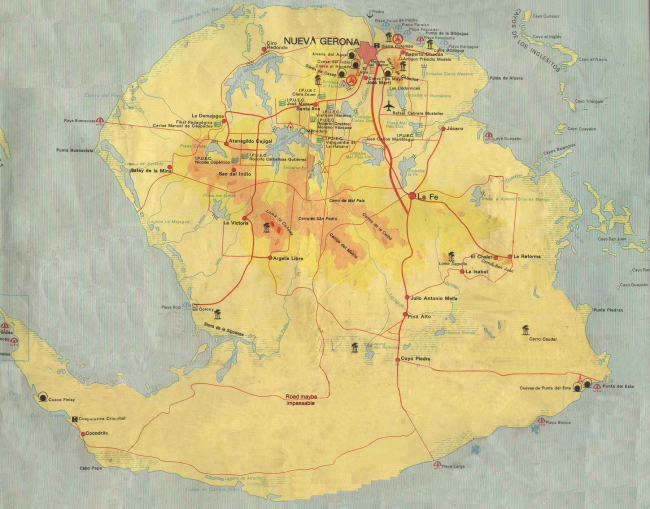
Isla de la Juventud (Isle of Youth), is situated about 100km off the south coast of mainland Cuba, is home to some of Cuba’s most important agricultural farmland and is a key producer of citrus fruits for export. The standard of living is generally higher, largely due to the preponderance of well cultivated, arable land which makes the problem of food shortages less pronounced than on the mainland.
The Isle of Parrots, The Isle of Pirates, The Isle of Treasure, The Isle of Pines and nowadays, The Isle of Youth are the different names that this island has received. Columbus discovered it on his second journey to the New World.
From 1953 to 1955, Cuban leader Fidel Castro was imprisoned in the Presidio Modelo on the Isla de la Juventud by the regime of Fulgencio Batista after leading the failed July 1953 attack on the Moncada Barracks in the Oriente Province.
The island is split into two fairly distinct topographical sections, north and south, and is dissected by a large swamp which runs from the southeast coast to the southwest coast. The north is generally flat and dry although there are a few marble hills near Nueva Gerona and the area is heavily farmed for citrus fruits. The harvesting of the grapefruit in January is marked by one of the country’s biggest and best festivals.
The beaches in the north are black sand and generally disappointing, in the south there are some superb white sand beaches, so if you want a holiday centered around palm fringed beaches and calm crystal-blue seas then the south coast of the Isle of Youth is a good a place as any.
Cayo Largo del Sur
Cayo Largo del Sur, also known simply as Cayo Largo, although only a relatively small 17 miles (27 Km) long island it is blessed with an almost continuous stretch of pretty beach, notably along its south coast. There are six beaches all of which will be able to satisfy your sun and sand lust: Playa Sirena, Playa Lindaman, Playa Blanca, Playa los Cocos, Playa Tortuga and Playa Luna.
But as if surrounding it with fine white sands was not enough. Cayo Largo was given the gift of being eternally caressed by clear and gentle water of incredible hues of blue. When you finally arrive in Cayo Largo you will be surprised to find a natural environment that practically has not changed at all since the world began.
There is an abundance of natural wildlife including iguanas and giant sea turtles. Close by is a small group of islets, the best known of which is Cayo Iguana. The protected coral reef around the island makes for good diving; the reef itself stretches for more than 30km and includes the rare and protected black coral.
Nueva Gerona
It is the capital of the island and the only thing that constitutes anything remotely resembling a town,
It is a busy and relatively prosperous town and the small but colorful streets have a provincial Latin America, rather than distinctly Cuban, feel about them. Many of the African students who study on the island are based here and the town has a more cosmopolitan atmosphere than most other towns and cities outside Havana. Also they contribute towards the island’s citrus fruit industry.
Parque Central on Calle 39 is the place where many of Nueva Gerona’s young congregate. At weekends it is also home to some excellent live salsa and if you are visiting the city this is a good place to start, it is also home to the local tourist information office and to the most of the town’s cafes and restaurants.
Outside Nueva Gerona you can find Model Prison, El Abra Museum, Beach of Black Sand and Punta del Este Caves….
Siguanea Beach
Siguanea Beach is located on the shores of Siguanea Bay, on the central western coast of the Island of Youth. It is just 5 minutes away from Siguanea’s small airport and 35 minutes from Havana by plane. It is a 25 mile drive from Nueva Gerona brings.
On the beach is situated El Colony Hotel, with 77 air conditioned rooms, bathroom and TV. Restaurants, snack bar, sea bar and night club. Swimming pool, sport areas and water sports. Medical services. Telephone and international fax: Rent a Car. Horse riding and other activities are available.
Cuba’s International Scuba-Diving Centre is located on a small Marina in Ensenada de la Siguanea. A multi-lock hyperbaric chamber is available at the Diving Center. A physician specialized in hyperbaric medicine is ready to provide preventive services and diving diseases treatment.
El Colony diving zone is located within the limits of the breath-taking paradise of Punta Frances Marine National Park. This comprises of 6 km. (4 miles) of coast, between Punta Pedernales and Punta Frances. The zone is very well protected with a remarkable environmental stability, thus having an exuberant reef development.
There are 56 attractive diving sites, some of them in areas of dense and colorful populations of corals, gorgonians and sponges. Others are located where the drop-off falls sharply, also more than 20 caves, passages and tunnels, coral hillocks and valleys are included.
The kind of fish varies from one site to another, so we can find schools of tarpons, spadefish, jacks, grunts, schoolmasters and yellowtail snappers. Nassau groupers, black groupers and barracudas are frequently found, also there are turtles, eagle rays and sometimes sharks. Among the most spectacular sites you can find are: Pared de Coral Negro, Tunel del Amor, Cueva Azul, El Pasaje Escondido, Cueva de los Sabalos, Piedra de Coral, EL Salto, Ancla del Pirata, Paraiso de las Levisas and Pequeno Reino.
Others diving zones are Los Barcos Hundidos, which are remains of sunken ships scattered on an extensive are between 6 and 9 meters (20 or 30 feet) deep, with many school of fish, including barracudas and stingrays, and a numerous sessile fauna attached to the ships. Los Indios, known for its vertical walls and big coral hillocks with sand beds, and Fuera de Limite, a peculiar place where the coral reef grows from the coast and falls into 15 meters (49 feet) deep, with big rocks full of corals, gorgonians, sponges and many coral fish.
Cienfuegos
Once a predominantly agricultural province, Cienfuegos has undergone substantial development since the Revolution and is now one of the most industrialized of all the provinces.
Its location on the southern coast of central Cuba has made it vulnerable to attack from pirates and corsairs through the ages. As the Cuban authorities look towards promoting tourism on their island, so Cienfuegos has begun to gear up to accommodate a more welcome type of visitor.
Since much of the province is relatively flat, the scenic foothills of the Escambray mountains in the east seem all the more dramatic. There are several unspoiled beaches stretching along the coast towards the province of Sancti Spiritus. Scuba diving off Cienfuegos province is extremely popular both with tourists and locals. There are numerous underwater caves, and well over 50 dive sites in the province.
Sugar is the area’s main crop, with much of it being exported from the port of Cienfuegos, the capital of the province.
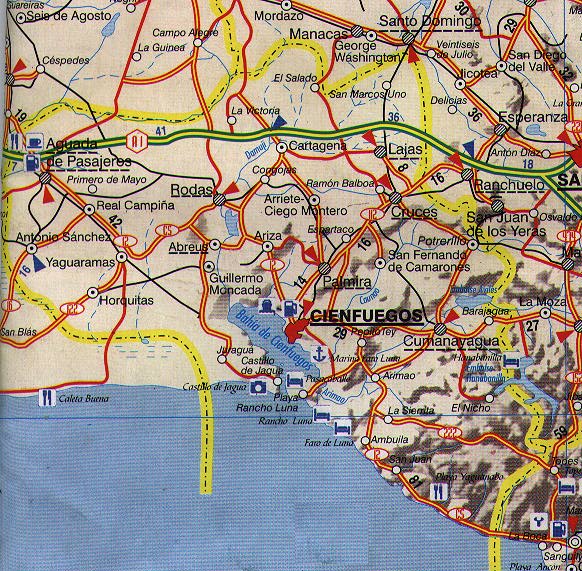
Cienfuegos City
Cienfuegos is a delightful and interesting city with a history largely different to that of the rest of the country.
It is a pleasant city which, because of its role as an important port, both domestically and internationally, has a slightly more cosmopolitan feel about it than most other areas in the south. The streets are straight and wide with the Paseo del Prado, which dissects the city and extends out to the peninsula’s end, being the most important street. The street extends south through the Punta Gorda area and north along the bay, there are some excellent views to be had from here, especially at sunset when the bay takes on a quiet and brooding appearance.
If you visit Cienfuegos don’t forget to see:
Parque Jose Marti, on the eastern side of it is the impressive Catedral de la Purisima Concepcion, which was built in 1870. Also overlooking the park is the Provincial Government Palace, a grand building with great columns and marble floors. Due west of the park stands the Casa de la Cultura.
Teatro Tomas Terry, situated on the north side of the Parque Jose Marti, is a beautiful and impressive structure whose facade is topped by three multi-colored mosaic murals.
Museo Historico, which contains local military memorabilia that once belonged to those who took part in the various struggles for independence and freedom.
Palacio del Valle, on the Punta Gorda, this Moorish style country house was bought by Alejandro Suero Balbin. Its fading pink colors fail to diminish the overall grandeur of the building which contains some excellent furnishings and porcelains.
The botanical gardens is perhaps the most famed botanical garden in the country, housing over 2,000 tropical and sub-tropical plants. Among the impressive collection of plant species are more than 200 types of palm trees of araceae, there is also a collection of different types of palm trees indigenous to Cuba.
Playa Rancho Luna, situated 20km east of the city, is still very quiet and secluded.
The Castle of Our Lady of the Angels of Jagua, situated 22km from Cienfuegos city, was originally used by the Spanish as a small fort to keep out smugglers who used to enter Jagua Bay to obtain fresh water and food from the locals. It is now a much more substantial structure following the Spaniards’ decision to develop it to defend the city from the more forceful threat offered by the English navy during the war between Spain and England.
Guajimico & Yaguanabo
Guajimico, the Indian name meaning “The place for fishes” is the river and coastal inlet below Guamuhaya massif between Cienfuegos and Trinidad. Villa Guajimico operated by Campismo Popular is situated here.
Playa El Ingles is between Guajimico & Yaguanabo.
Yaguanabo can be enjoyed from small but comfortable cabanas (operated by Islazul) in a protective screen of vegetation. Here, you can relax in peace and quiet broken only by the squabbling of local birds and the soothing sound of the river. In the villa, everything is designed to promote enjoyment, with various recreational activities, such as boat rides on the Yaguanabo River to Iguana Valley, horseback riding, swimming in the river and evenings at the villa’s discotheque.
Cruces
Cruces is a town in Cienfuegos Province, Cuba. It is the home of the Mal Tiempo National Park which commemorates a battle in the 1895 War of Independence.
Playa Rancho Luna
Rancho Luna Beach is located just outside of Cienfuegos. The semicircle-shaped, soft sand and beach is bathed by peaceful and warm waters. There are different diving areas nearby. Its coastal platform is particularly rough and inhabited by a rich marine life; its shallow waters hide beautiful corals that form low and medium depth reefs in the Barreras Cove and in Las Playitas; abrupt underwater geography and abundant sponges, gorgonians and corals are located much deeper and are particularly enticing.
Considered the Cuban architectural jewel of the 19th century, Cienfuegos is outstanding for the perfect design of its streets and for the refinement and good taste of the buildings in the historic center of the city, which has been declared a national monument. When visiting, stop by the Casa del Fundador (Founder’s House); Nuestra Señora de la Purísima Concepción (Our Lady of the Immaculate Conception) Cathedral; Tomás Terry Theater; Ferrer Palace; and José Martí Park, which contains the only arch of triumph in Cuba.
Other attractions include the Prado Promenade, Valle Palace, Museums of Naval and Provincial History, Reina (Queen’s) Cemetery and Jai-Alai Courts.
Farther out from the center of the city, tour the Nuestra Señora de los Angeles de Jagua (Jagua for short) Fortress, Tomás Acea Cemetery and the Botanical Gardens.
In addition to these cultural and historic attractions, Cienfuegos has excellent facilities for scuba diving and other water sports, nature tourism and thermal baths.
La Havana
Havana is probably the most exciting city in Latin America managing to be both seedy and stylish. The Havana province owes its growth and prosperity to the almost natural perfection of its harbor. The Spanish, in the course of their conquest of Central and Latin America, earmarked the city as the ideal stopping-off point for their ships. In order to protect their vessels from English, French and Dutch attack, the Spanish built a wall around the city and constructed huge fortresses at the entrance to the harbor.
As Cuba’s political and economic center, it has become a museum to a broken communist dream, yet it is much more than just that: it is the focus of Cuba’s youth culture; the place where you’ll find the most magnificent hotels and the liveliest discotheques, where the Revolution seems to have come full circle and, uncannily, recreated the absurdly decadent world of Graham Greene’s Our Man in Havana.
Havana is an exhilarating place, but it can also be exhausting. There is a neurotic, anxious edge to life here, quite unlike anything you’ll find in the rest of Cuba.
